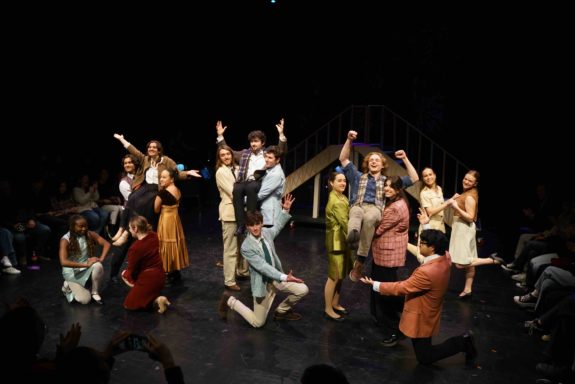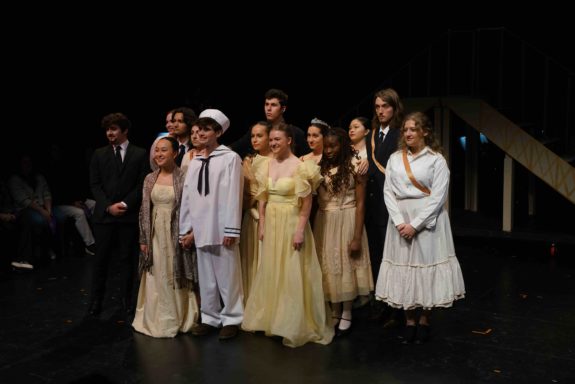On Saturday, April 13, Staff Writer Sofie Huang attended the opening of Columbia Musical Theatre Society’s production of Anastasia, which ran on April 12 and 13 at the Glicker-Milstein Theater.
The Columbia Musical Theatre Society returned to the Glicker-Milstein Theater this weekend with a production of Anastasia. The musical, directed by Owen Mefford (CC’24) and co-produced by Sophie Sandler (BC’25) and Emmanuelle Stith (BC’27), is based on the 20th Century Fox Animation film Anastasia (1997). The musical follows an orphaned girl, Anya, played by newcomer Caroline Nieto (CC’27), who sides with two con men Dmitry, played by Ethan Paulk (CC’25), and Vlad, played by Nathan Rakolta (CC’27), on a mission to Paris to prove to the Dowager Empress Maria Feodorova, played by Tatiana Mroczek (BC’25), that she is the lost Grand Duchess Anastasia Romanova. The musical makes several departures from the film, such as the addition of a more complex antagonist in Bolshevik general Gleb, played by Tommy Doyle (GS’24).
On a personal note, I was familiar with the musical going into the show, so I knew how the plot would unfold and how the music should sound, which gave me an informed but biased view of the musical. I attended the second showing on Saturday afternoon, but other Bwog staff attended the first on Friday evening, and with their contributions, there were slight production differences between the two shows. I will be reviewing mine but with slight notes from their experiences.
The musical begins with an already emotionally poignant note, depicting the last time Anastasia sees her grandmother, with a subsequent ballroom scene. The Romanov family are then attacked and flee from an unknown entity, assumed through historical context to be the Bolsheviks. The setting then reopens on St. Petersburg. Through the first act, the cast and ensemble accomplish a fun and comedic St. Petersburg, while also balancing the more serious scenes. These seamless scenic transitions were choreographed by Eden Johnson (CC’25), and the work of translating a ballroom scene into a small space was just as successful as the more scrappy nature of St. Petersburg. The dancing was in tune with the musical all the way through and made the scenes recognizable and fun. There was some struggle with the stage size, mostly in the ballroom scenes, where ensemble members seemed unsure how to adapt choreography to the smaller space of the Glicker-Milstein Theater. There were some cast members that had a difficult time dancing while also making sure not to accidentally touch the audience. Still, these stumbles did not take away from wider choreographically excellence, the placement and choreography of ensemble members throughout certain scenes, like “Stay I Pray You” and “Quartet at the Ballet” were interesting and dynamic, and they were able to convey the mood well.
The characters were well-cast and the three main characters, Anya, Dmitry, and Vlad had the chemistry to carry numbers like “Learn to Do It” where the music is reliant on the ability to carry out a comedic tone. Nieto, playing Anya, is brilliant and a standout from beginning to end, hitting every note, musical and theatrical, without struggle. This is especially showcased in her solos: “Journey to the Past”, where Nieto conveys Anya’s yearning confusion about her self-discovery, and “Once upon a December” where she recounts the little memories Anya has. Nieto illustrates the pain and anxiety that Anya embodies throughout the play, but not leave out her hopefulness and willingness to love. This strong performance extended to her duets and trios with Paulk, playing Dmitry, and Rakolta, playing Vlad, as well as her final duet with Mroczeck, playing the Dowager Empress. Paulk and Nieto perform a convincingly romantic ballad, “In a Crowd of Thousands”, in the second act. Paulk was exceptional, and his demeanor in his solos “My Petersburg” and “Everything to Win” impressively demonstrated the changes in Dmitry’s character throughout the story. He was able to deliver the annoying bad-boy aesthetic required of the role, while also showing his vulnerability as the story extends into Act II. Rakolta as Vlad comedically balanced out the more romance-heavy parts of the plot and made the production much lighter and funnier. He was able to bring humor to a musical that is dominated by heavier themes of death, loss, and uncertainty, and the audience could reliably depend on Rakolta’s performance for a breath of fresh air. At some point during the show, his goatee was unintentionally falling off (later fixed), which only added to the humor of their performance. His small character interactions with the audience brought a sense of charisma to the fun, quirkier numbers.
In his last production in Columbia Theatre, Doyle graduates with a performance as Gleb Vaganov that explores the complexity within the character with grace, care, and resounding nuance. Doyle’s performance is impactful and the audience gets a sense of his inner conflict between his heart and his head, and between his father’s traditions and his own sense of righteousness. The performance is pretty serious throughout the entire musical, with songs like “Still” and “The Neva Flows”, which Doyle does in the frightening way the number asks of him. Yet, he is also able to portray a softness to Gleb’s character in “Still/The Neva Flows”, as well as deliver a more lighthearted scene where he admires his office with a working telephone. Columbia Theatre will surely be sad to see him go, but Doyle leaves the community with a beautiful complex depiction of the antagonist.
The more secondary characters were also well-cast, with Leticia Gorberg Valdetaro as Countess Lily Malevski-Malevitch performing “Land of Yesterday” with the necessary comedic tone and the 1920s style of singing that brings a fun tune while lamenting their aristocratic losses. Valdetaro is also entertaining and lively in her duet with Rakolta, “The Countess and the Common Man”, where she is supposed to be mad at Vlad, only to be pulled in by his charms. Tatiana Mrozcek as the Dowager Empress was moving, as most of the Empress’s pieces are deeply emotional as in “Close the Door”. I found her conversation with Anya to be a bit sudden, as the Empress was so steadfast in her belief that Anya was not who she was looking for for a while. A bit more of a gradual performance could have delivered the scene a bit better, but Mrozcek and Nieto’s dual performance in “Once Upon a December (Reprise)” does elevate the scene a lot more. Mrozcek plays an elegant grieving Empress, and her ability to put shakiness into her voice and incorporate an older sound is breathtaking in her own right. Other small ensemble members, like Matt Vitello’s (GS’24) brief performance as Count Leopold, and Arya Bailan (CC’26) as the comrades that report Anya all play to push the historical fiction forward.
The set, designed by Jasmine Chen (BC’25) and Nathan Zepeda (CC’26), was simple but used effectively. The two rolling staircases were used to create a mountainous ledge over Paris, a bridge, a train, a scene from Communist Russia, and other settings that served the plot well. There were some moments where I doubted that ensemble members needed to move the stairs apart just to put them back together, but this did not take away from the design, though did take up a bit of transition scenes. The tables that were moved in and out of the scene, as well as the couch used for bedroom scenes were uncomplicated but helped make the setting easily recognizable to audiences. The props, designed by Miranda Ye (BC’27), were setting appropriate and the primary focus was on the music box, as well as the main characters’ briefcase. One of the briefcases was a bit broken, but Paulk was able to continue the scene and close it when necessary. The music box was used in a number of scenes and was sparkly and stood out in the setting. The costumes, designed by Namya Manghnani (CC’27), were working within the confines of a small budget to produce period costumes, which was sometimes successful and other times a little bit silly. There were standouts to the design choices, as Anya’s last red dress made the audience gasp with delight. The three piece tweed suits worn by Dmitry and Vlad were appropriate and well-fit for the setting. The dress worn by Mrozcek was beautiful and convincing for a mourning Empress. I found myself particularly disliking Anya’s blue dress worn for meeting her grandmother, which was unflattering and slouchy. The large sailor outfit worn by Kyle Sneer (CC’27) as Alexei, was a little bit confusing and felt out of place in the midst of other costumes. Overall the costumes worked well as a student production attempting to mimic a historical period, with some misses here and there.
The lighting and sound, designed by Nalyah Deloatche (CC’27) and Laura Ziessler (BC’27), respectively, worked well together to create more special scenes, like the camera flashes at the beginning of the first act, meant to mimic a family portrait, as well as the thunder and gunshots, as danger approaches. Some Bwog Staff had gone to the first showing and reported that the microphones were faulty, but by the second showing, many of those issues had been fixed. Even if there were some microphone issues, the cast was able to project above the pit orchestra, flawlessly picking back up when the microphone came back in. The use of spotlights and the background projections served the mood of the scene and the focus on certain characters well. There was never a question of whom the audience should be paying attention to.
Anastasia the Musical delivered a stunning performance with a well-fitted cast complete with beautiful pit orchestration, which helped the audience overlook the slight inadequacies in the technical production, while also projecting the successes of the technical production when everything was flawless.


Photographs by Olivia Kuan-Romano


 0 Comments
0 Comments